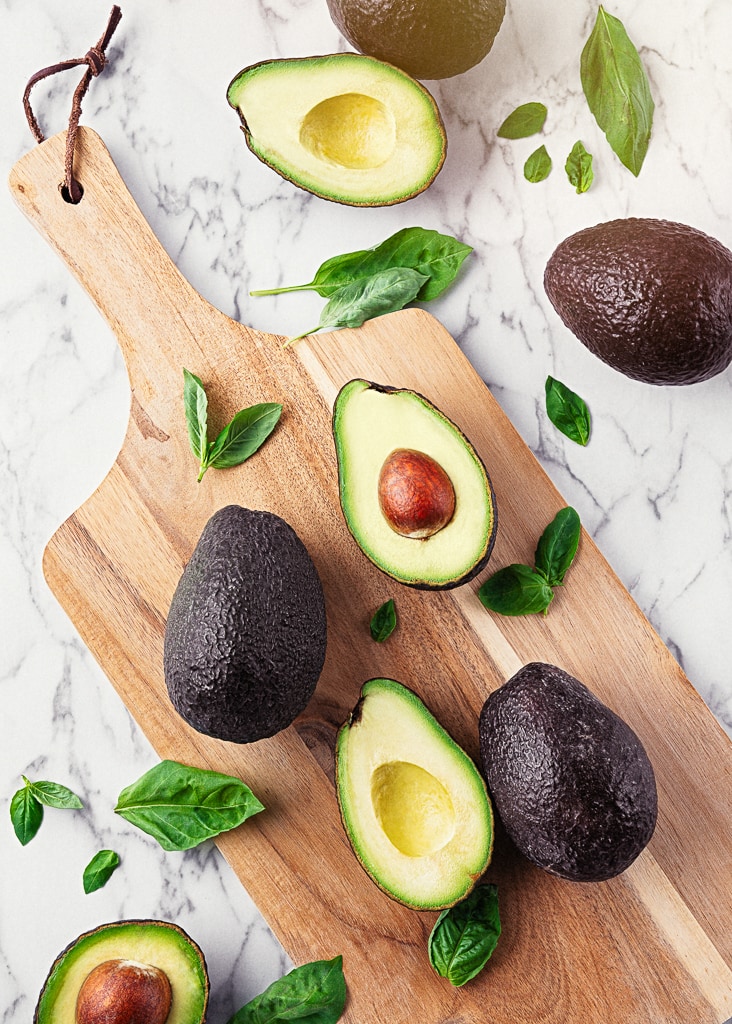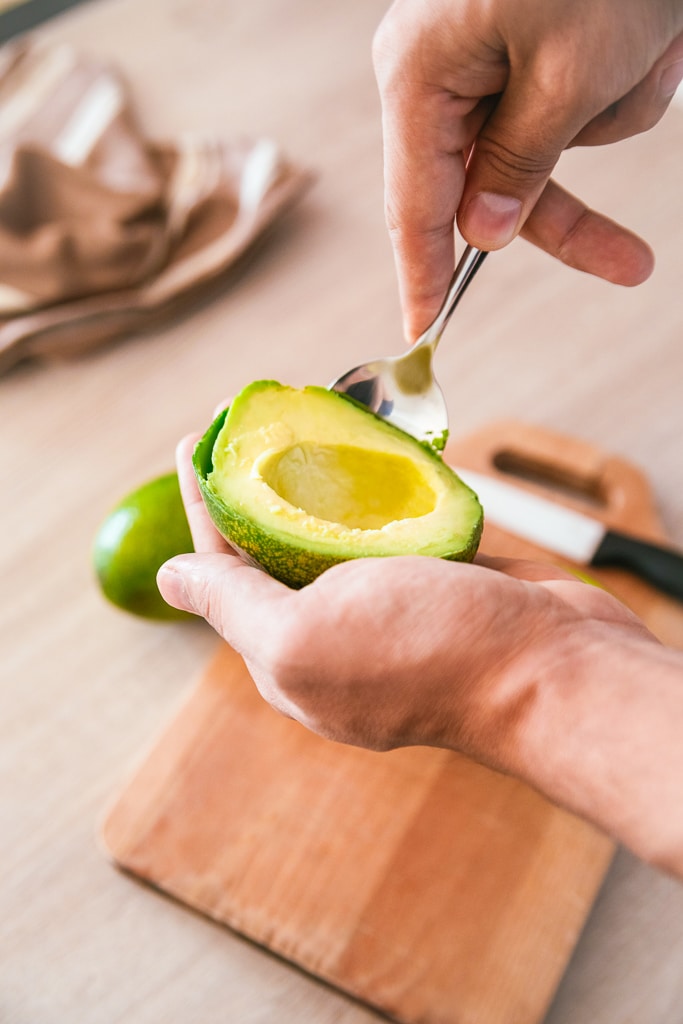How to Tell if an Avocado is Ripe
Have you ever brought an avocado home from the store only to realize that it’s not ripe yet? Don’t feel bad, a lot of us have. Picking the perfect avocado doesn’t have to be difficult. There are a few things to look for that will help you pick the perfect avocado. Let me show you how!

We love avocados at my house! There are nearly always some on the kitchen counter and others in the refrigerator waiting to be used for my favorite tomato avocado sandwiches, and we like to add them to veggie bowls and tacos too.
Over the years, I’ve learned a number of tricks to help make sure that we always have perfectly ripe avocados on hand for any time we need to use them. I can’t wait to share some tricks and tips with you!

How to tell if an avocado is ripe
Watching people in the produce section at the grocery store can sometimes be comical. Folks are sniffing and squeezing the avocados and other produce trying to figure out which ones are ripe.
There are methods to help choose an avocado that is ready to eat, and they actually work pretty well. To determine if an avocado is ripe, try some of these tips. They will have you eating this smashed chickpea avocado sandwich and easy avocado toast in no time!
- Check the color: Ripe avocados often have a dark, almost black skin. However, this can vary depending on the avocado variety, so it’s best to consider color along with the other indicators.
- Gently squeeze the avocado: Apply gentle pressure to the avocado with your palm, avoiding using your fingertips. Ripe avocados should yield to gentle pressure but still feel firm. If it feels overly soft or mushy, it may be overripe or even rotten. If it feels hard and unyielding, it is likely unripe.
- Check the stem: Pop off the small stem or cap at the top of the avocado. If it comes off easily and reveals green flesh underneath, the avocado is generally ripe. If it is difficult to remove or shows brown discoloration, it may be overripe or starting to spoil.
- Consider the weight: Ripe avocados typically feel slightly heavy for their size. If it feels unusually light, it may be underripe, while a significantly heavy avocado could indicate it is overly ripe or has started to spoil.
Remember that avocados can ripen at different rates, so it’s a good practice to buy avocados at various stages of ripeness to ensure you have ripe ones ready when needed.
Can you eat an avocado that is not ripe?
While it is technically possible to eat an unripe avocado, the taste and texture will not be as desirable as a fully ripe avocado. Unripe avocados are typically hard, lack a creamy texture, and have a mild or even bitter flavor.
Sometime back, my only avocado was still too firm, but I decided to try it anyway because we were making avocado tomato sandwiches for dinner. I will go ahead and tell you it was a mistake. The taste was too bitter to enjoy, so I had to toss it out.
Unfortunately, once you cut open an unripe avocado that is too hard, there’s not much you can do to improve the taste and texture. That is a big unfortunate waste!
Avocados ripen after being picked, so it’s best to wait a few days until they are fully ripe before consuming them for the best eating experience.

How to ripen an avocado
In my experience, the best way to ripen an avocado is to set it out on the kitchen counter and give it about 4-5 days, depending on how firm it is. When I buy a bag of them at my local Aldi’s, it tends to take about 5 days before they are ready to eat.
If you have an unripe avocado and want to speed up the ripening process, I have been told that you can place it in a brown paper bag with an apple or a banana. These fruits release ethylene gas, which can help accelerate the ripening of the avocado.
Keep the bag at room temperature and check on it daily. It may take a few days for the avocado to ripen properly. Like I said, I haven’t needed to do it but, if you are in a hurry, it is worth a try and could shorten the ripening process by a couple of days.
If you have more than one avocado, I suggest allowing them to ripen at room temperature for a few days and then putting them in the refrigerator so they will hold that ripeness without getting too ripe before you can use them all. I do this all the time, and it works great.
Slow down the ripening process
To slow down the ripening process of an avocado, you can try these tricks:
- Refrigeration: Place the avocado in the refrigerator. The cooler temperature slows down the ripening process. You can place it in the produce drawer or wrap it in a paper towel to help absorb excess moisture.
- Store it whole: Keep the avocado intact and avoid cutting it open if you want to slow down the ripening. Once an avocado is cut, it tends to ripen faster.
- Plastic wrap: If you have already cut open the avocado and only used a portion of it, wrap the remaining portion tightly in plastic wrap. Make sure there is minimal air exposure, as it can speed up the ripening process.
- The pit: I don’t know how scientific this is, but I have found that storing the pit with the cut avocado helps keep it from turning brown too fast. Even when I make a recipe with avocado such as chickpea avocado salad, I put the pit in the container with the leftovers.
- Lemon or lime juice: Squeeze some lemon or lime juice over the exposed flesh of the cut avocado. The citric acid can help slow down enzymatic browning and slightly delay the ripening.
Remember that refrigeration can significantly extend the time it takes for an avocado to ripen, so keep an eye on it and adjust your plans accordingly. When you’re ready to use the avocado, remove it from the refrigerator and allow it to come to room temperature for better flavor and texture.
Should you refrigerate avocados?
While it is generally not necessary to refrigerate unripe avocados, once they are ripe, refrigeration can help prolong their shelf life. Refrigerating ripe avocados slows down the ripening process and can give you a few extra days before they become overripe.
If you have a ripe avocado and you want to extend its freshness, you can place it in the refrigerator. However, it’s important to note that refrigeration can affect the texture and flavor of avocados. Cold temperatures can make the flesh slightly firmer and potentially dull the flavor. Therefore, if you prefer a creamy and flavorful avocado, it’s best to consume it at room temperature.
If you have unripe avocados that you want to ripen, it’s better to keep them at room temperature until they are ready. Placing unripe avocados in the refrigerator can significantly delay the ripening process and may result in an uneven ripening or an avocado that never fully ripens.
So, while refrigeration is suitable for ripe avocados if you want to prolong their shelf life once they are ripe, it’s not necessary for unripe avocados and can impede the ripening process.
How to cut an avocado
Once your avocado is perfectly ripe, it’s ready to use. If you haven’t cut an avocado before, these steps will help make it a smooth and easy process.

- Select a ripe avocado: Look for an avocado that is slightly soft to the touch but not mushy. The skin should be dark and may have a slight give when gently pressed.
- Wash the avocado: Rinse the avocado under cool water to remove any dirt or debris on the skin.
- Prepare your cutting surface: Place a cutting board on a stable surface. Make sure the board is large enough to accommodate the size of the avocado.
- Cut around the avocado: Hold the avocado firmly and make a lengthwise cut around the avocado, starting at the stem end and rotating the knife along the pit until you reach the starting point. Apply gentle pressure and slice through the skin until you reach the pit.
- Twist the halves apart: Hold each half of the avocado and twist them in opposite directions to separate them. One half will contain the pit.
- Remove the pit: To remove the pit, carefully strike it with the blade of a knife, embedding the blade slightly into the pit. Twist the knife gently, and the pit should pop out. Exercise caution when doing this to avoid injury.
- Scoop out the flesh: With a spoon, gently scoop the flesh of the avocado out of the skin. Start from the top, near the stem end, and slide the spoon along the inside of the skin, separating the flesh.
Now you have two avocado halves with the pit removed. You can slice, dice, or mash the avocado flesh as desired for your recipe or serving preference.
Remember to exercise caution when using a knife, and if you’re new to cutting avocados, it’s always a good idea to practice safe knife-handling techniques.
These are just a few ideas to get you started but feel free to explore and experiment with avocados in your favorite dishes. Avocados’ mild, creamy flavor and versatile nature make them a delightful addition to many recipes.
For those of you new to the whole food plant-based lifestyle, we’ve created a FREE 7-Day Plant-Based Menu Planner to help you get started!
About Terri Edwards
Hi guys! I am the content creator behind EatPlant-Based and a licensed Food for Life instructor with the Physicians Committee for Responsible Medicine. I am passionate about sharing healthy recipes and tips to empower others to get healthy. I’m so glad you’re here! Read More…




